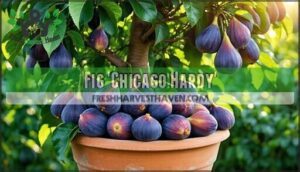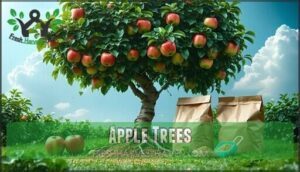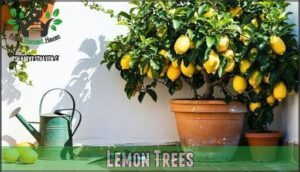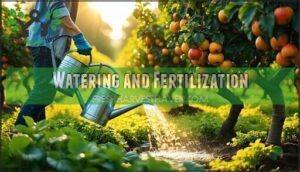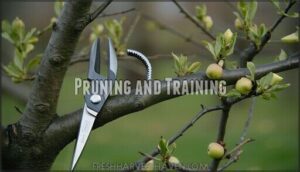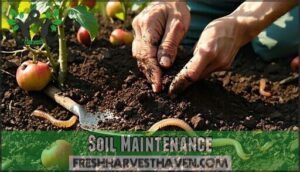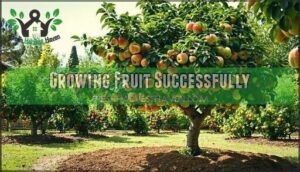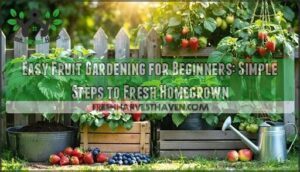This site is supported by our readers. We may earn a commission, at no cost to you, if you purchase through links.
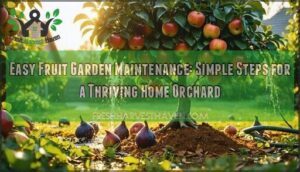 Easy fruit garden maintenance starts with picking the right trees for your climate—think figs, apples, or even a tough little ‘Chicago Hardy’ if you like something sweet and simple. Water just enough so your trees don’t throw a tantrum, mulch to keep weeds at bay, and prune like you’re giving your plants a fresh haircut.
Easy fruit garden maintenance starts with picking the right trees for your climate—think figs, apples, or even a tough little ‘Chicago Hardy’ if you like something sweet and simple. Water just enough so your trees don’t throw a tantrum, mulch to keep weeds at bay, and prune like you’re giving your plants a fresh haircut.
Keep an eye out for pests, but don’t sweat the small stuff—a little vigilance goes a long way. Regular soil checks and some compost can turn mediocre into marvelous. Stay tuned as we share secrets even seasoned growers wish they’d known sooner.
Table Of Contents
- Key Takeaways
- Choosing Fruit Trees
- Easy Fruit Trees
- Fruit Garden Care
- Low Maintenance Fruits
- Growing Fruit Successfully
- Frequently Asked Questions (FAQs)
- How do you care for a new fruit plant?
- How do you grow a fruit tree?
- Should you plan your fruit trees each year?
- How do I choose easy fruits to grow at home?
- What fertilizer do fruit trees need?
- How long can I harvest from my fruit trees?
- What is the 3-hour gardening rule?
- What is the best low maintenance fruit to grow?
- What is the 3 year rule in gardening?
- What is the most common mistake of first time gardeners?
- Conclusion
Key Takeaways
- Pick fruit trees that fit your climate, soil, and space so you don’t battle weather or waste effort.
- Water deeply and check soil pH every season—good roots mean better harvests with less hassle.
- Prune regularly and use mulch to keep your trees healthy and the weeds under control.
- Choose easy, disease-resistant varieties like figs or blueberries to save time and skip the drama.
Choosing Fruit Trees
Picking the right fruit trees isn’t rocket science—you just need to match your choices to your climate, soil, and space.
Trust me, choosing a tree that fits your yard now saves you from hauling buckets of water in August or wondering why your apple tree looks grumpy come spring.
Climate Considerations
Your garden’s success story begins with understanding your climate zone—it’s the map to good fruit. Study those hardiness zones and local weather patterns so your trees don’t meet a frosty end.
Watch for seasonal changes, especially if your area has wild mood swings or extreme weather. Microclimate selection is like finding the cozy nook in your backyard, perfect for extending your growing season.
Chill hours, regional variations, and a few frost protection tricks help you match fruit trees to your yard’s personality.
Soil Type and PH
Some days, your fruit trees feel like picky eaters—they only thrive if the soil conditions are just right. That means thinking about soil type, pH, and good drainage from day one. Most fruit varieties need a soil pH between 6.0 and 7.0, so reach for that soil testing kit before planting. Got acidic soil? No worries. pH adjustment is as simple as adding a handful of lime or organic amendments like compost. Soil amendments are generally unnecessary when planting fruit trees.
- Boost nutrient availability with regular soil testing.
- Tackle drainage solutions early by mixing in compost for healthy roots.
- Never skip checking soil pH; it saves you headaches down the line.
Strong trees start with strong soil.
Hardiness Zones
Let’s face it—trying to outsmart Mother Nature is no picnic. With USDA zones and zone mapping, you’ll match each fruit tree to your spot’s true climate zone, making fruit garden maintenance far easier. Microclimates impact everything—a sunny fence, for instance, might grant you an extended season. Keep an eye on zone changes, too. Sometimes, climate quirks mean you can grow what your neighbors can’t! For beginners, small fruits are easier to manage.
| Zone Mapping | Microclimates Impact | Plant Adaptations |
|---|---|---|
| Reveals best trees | Suntrap walls boost warmth | Some thrive in shifting zones |
| Easy fruit garden maintenance | Extended seasons possible | Adapt with changing climates |
Disease and Pest Resistance
Picture your fruit trees as scrappy boxers in the ring—what keeps them standing? Disease and pest resistance that packs a punch! To knock out headaches:
- Pick disease-resistant and resistant rootstocks—they’re like body armor for pest control.
- Practice Integrated Pest Management using natural predators and organic solutions.
- Use preventative measures: prune for airflow, space trees, and catch pest susceptibility early.
Stay sharp and those bugs won’t stand a chance!
Easy Fruit Trees
You don’t need a green thumb to enjoy fruit trees that basically take care of themselves—think figs, apples, lemons, peaches, and cherries.
Pick the right spot, plant them at the right time, and you might spend more time bragging about your harvest than actually working for it.
Fig ‘Chicago Hardy’
A Chicago Hardy fig delivers winter hardiness you can bank on—these figs survive cold snaps down to -20°F. They’ve mastered container growing and barely need a trim, making them one of the easiest fruit trees for Easy Fruit Garden Maintenance.
With sweet, dependable fruit quality and strong pest resistance, you’ll spend less time fussing—more time savoring.
Apple Trees
Apple trees are the Swiss Army knife of easy fruit garden maintenance. With countless apple varieties to choose from, even beginners can feel like orchard pros.
Master grafting techniques to get the best mix of flavors on one tree. Remember their pollination needs—most apples want a buddy.
Stay on top of fruit tree maintenance like pruning and feeding, and you’ll dodge common diseases and enjoy basketfuls come harvest.
Lemon Trees
Anyone looking to master Lemon Trees will find Meyer lemon varieties a joy—think container growing on a sunny patio or even indoors. Dwarf citrus trees make fruit tree care easy, but you’ll want these steps in your toolkit:
- Water deeply; wait for soil to dry (no soggy roots!).
- Fertilize monthly for juicy lemons.
- Prune dead wood, keeping the canopy tidy.
Use smart pest control and winter protection for year-round zing.
Peach Trees
Next up, Peach Trees. Choose self-fertile peach varieties—no need for a pollination partner. Deep watering and fertilizing peaches early each season sets the stage.
Pruning peaches in late winter isn’t just for looks; it boosts healthy fruit. Be on the lookout for peach diseases and pests during the season.
Harvesting peaches? Mid-summer, fragrant, and a little soft—now that’s a sweet win.
Cherry Trees
Under a cherry tree, spring feels like confetti season—blossoms everywhere and birds scouting your crop before you even get a taste. To keep your fruit garden maintenance a breeze, look for varieties like ‘Stella’ that ace cherry pollination without a partner. Sweet vs. sour isn’t just taste—it’s care level, too. For easy fruit garden maintenance, try smart bird protection and keep trees manageable with the right rootstock. Get ahead with pruning cherries and don’t let cherry diseases sneak in. With a little practice, you’ll master these four steps:
- Harvest cherries firm and well-colored
- Pick during dry weather
- Cut stems, don’t yank
- Store cherries cool
Fruit Garden Care
Caring for your fruit garden isn’t rocket science—just a little timing and the right moves, and you’ll be sneaking out to snack on homegrown treats before you know it.
Remember, regular watering, smart pruning, and some light pest patrol can mean the difference between a fruitful summer and a feast for the squirrels.
Watering and Fertilization
You’ve picked the right fruit trees—now let’s talk watering and fertilization without giving yourself a headache. Fruit tree watering works best when you soak the roots, not just sprinkle the surface. Stick your finger in the soil: if it’s bone dry two inches down, it’s time.
Watch for yellow leaves—they’re your tree’s way of asking for more soil nutrients! Don’t be afraid to try organic options for happy, healthy roots.
Use the table below to match watering frequency and fertilizer types to each season.
Season Watering Frequency Fertilizer Types
Pruning and Training
Your fruit tree’s best look starts with a little Dormant Pruning in late winter. Grab clean, sharp tools for smarter Tool Selection—this helps every cut stay clean.
Focus on minimal pruning; just remove deadwood and messy branches to let in light. Shape growth by training limbs outward, creating a tree that breathes and fruits well.
Wound sealing isn’t usually needed—nature’s got it handled for easy fruit garden maintenance.
Pest and Disease Management
Think of pest and disease management like running a neighborhood watch for your fruit garden. Start with pest monitoring—know who’s crashing your party. Choose disease-resistant varieties; it’s like locking your doors before trouble arrives.
Rely on Integrated Pest Management: release beneficial insects, use organic pest control methods, and keep a close eye for trouble.
Disease identification is your secret weapon—spot issues early and nip them fast. With smart pest control and organic solutions, you’ll enjoy harvests instead of headaches, while helping your garden thrive.
Soil Maintenance
In terms of fruit garden success, solid soil maintenance makes all the difference. You wouldn’t plant a tree in quicksand, right? Start each season with soil testing—checking the soil pH and nutrients saves you headaches later on.
Keep your soil conditions in the sweet spot with these habits:
- Test yearly to stay on top of soil pH and nutrients.
- Blend in organic amendments, like compost or well-rotted manure, to boost drainage and fertility.
- Apply 2-3 inches of your favorite mulch—shredded bark, straw, or leaf mold—around your tree base to lock in moisture and cut down on weeding.
- Tweak the pH balance: If your test says “too acidic,” a sprinkle of lime can help; too alkaline, try sulfur.
Brighter trees start underground with the right soil preparation!
Low Maintenance Fruits
If you’re looking for a fruit harvest that won’t take over your weekends, low-maintenance options like strawberries, blueberries, or raspberries are your garden’s best friends.
You’ll spend less time fussing and more time snacking—plus, these plants know how to pull their weight without a lot of drama.
Strawberries
Strawberries are a true small-space superstar, thriving in containers and hanging baskets. When planting strawberries, choose healthy runners—trust me, they’ll reward you with plenty of fruit! Keep soil moist but not soggy, and set up a simple net to thwart strawberry pests like birds. With easy fruit garden maintenance, you’ll enjoy sweet, sun-ripened berries. For extra fun, use the table below to track your strawberry wins throughout the season.
| Task | Timing |
|---|---|
| Plant runners | Early spring |
| Mulch & water | Late spring |
| Check for pests | Weekly |
| Harvest | Fully red fruit |
Blueberries
Blueberries make easy fruit garden maintenance a breeze with their fuss-free style and sweet rewards. Pick blueberry varieties that fit your climate and see what you can harvest—if the birds don’t beat you to it! They’re happiest in acidic soil, with regular watering and the occasional gentle hand at pruning blueberries.
Here’s what to expect:
- Jewel-toned berries swinging on branches
- Glimmering morning dew on healthy leaves
- Fruit packed with flavor and antioxidants
- Playful garden companions fighting off blueberry pests
You’ll love this low maintenance fruit!
Raspberries
Chasing after blueberries? Raspberries offer just as much charm. You’ll find raspberry varieties—summer-bearing and everbearing—are perfect for lazy gardeners who don’t shy away from a little dirt. Choose well-draining soil with the right soil pH, set up a simple trellis, and master a few pruning techniques. Stay sharp with pest control and smart harvesting tips. Here’s your raspberry cheat sheet:
| Task | Timing | Pro Tip |
|---|---|---|
| Pruning | Late winter | Remove old canes |
| Soil pH | Test yearly | Aim for 6.0-6.5 |
| Pest Control | Spring/Summer | Netting wards off birds |
| Trellis Setup | Spring | Use sturdy posts |
| Harvesting Tips | Summer/Fall | Pick when berries give |
Blackberries
With blackberries, you really can have your pie and eat it, too. Trellising blackberries keeps those wild fruit bushes in check, especially the easycare, thornless blackberry varieties.
Master pruning blackberries once a year for fewer tangles:
- Cut out dead canes late winter
- Remove fruited canes post-harvest
- Thin to 6–8 canes per plant
- Watch for blackberry pests
Berry plants become season-long stars, with minimal fuss!
Grapes Alternatives
If you’re ready to skip the grape drama, you’ve got plenty of low maintenance fruits that’ll make your life sweeter—literally. Berry vines like raspberries and blackberries can sprawl or climb and still toss you baskets of fruit. Figs, honeyberries, and even passionfruit are excellent grapes alternatives—less pruning, more snacking.
Try kiwi vines for something fun, or ground cherries if you want a garden curveball. Blueberries and dwarf citrus trees add to your low-maintenance garden, making easy fruit garden maintenance feel like a breeze after a long week.
Growing Fruit Successfully
If you want fruit that’s juicy, sweet, and not a total fuss, pay attention to timing, soil, and space, and keep an eye out for any garden drama before it spirals.
It turns out, your fruit trees will do most of the heavy lifting as long as you give them a strong start and a little routine care—no green thumb wizardry required.
Planting at The Right Time
After picking low-maintenance fruits, don’t forget: Planting at The Right Time sets you up for success. Aim for Dormancy Planting—think bare-root trees in late winter or early spring, containers when the mood strikes (as long as it’s not frozen).
Keep an eye on Frost Dates, Climate Zone, and microclimate. Smart Seasonal Timing means quicker root development and fewer headaches.
Preparing The Soil
Getting the dirt right is half the battle in fruit gardening. Start with soil testing so you know your pH levels—most fruit trees love soil between 6.0 and 7.5. If your ground turns into a swimming pool after rain, focus on drainage improvement and add plenty of organic amendments like compost. It’s about building healthy, well-draining soil that makes roots happy. Think of it as prepping the best snack tray for your trees—except they want nutrients, not nachos.
- Test pH regularly
- Use organic matter
- Improve soil drainage
- Balance nutrients
Providing Adequate Space
In the case of fruit trees, cramming them together never leads to a sweet harvest. Think long-term! Planning for proper tree spacing lets each tree claim enough root space and enjoy sunlight access—even as their canopies fill out.
Standard apples hog the yard at 25–30 feet apart, while Dwarf Varieties cozy up at 8–10 feet. Give those roots well-draining soil and allow for vertical growth. Your trees will grow happier with plenty of air circulation and less drama.
Monitoring and Adjusting Care
After you’ve carved out space for your fruit trees, it’s time to put on your plant detective hat. Healthy fruit comes from smart, steady care.
Keep things running smoothly with this checklist:
- Adjust watering—don’t drown or starve roots; adapt to rain and heat.
- Fertilize during spring’s growth spurt.
- Watch for pest pressure—early action, less headache.
- Take soil health checks.
Tweaking as seasons shift keeps trees thriving. Remember, the best fruit comes from attentive hands!
Frequently Asked Questions (FAQs)
How do you care for a new fruit plant?
Think of your fruit plant as a new neighbor—welcome it by watering deeply, mulching for comfort, pruning in late winter, and checking soil pH.
Skip the helicopter parenting; sometimes, a little tough love grows the sweetest fruit!
How do you grow a fruit tree?
Start with a sunny spot and well-draining soil. Plant your tree during dormancy, water deeply, mulch, and prune in winter. Check soil pH every few years.
** Before you know it, you’re the neighborhood’s fruit whisperer!
Should you plan your fruit trees each year?
Every spring has its chores—don’t let your orchard run wild. Planning your fruit trees yearly keeps you ahead of trouble.
If you skip it, you’ll chase problems like squirrels after peaches, instead of enjoying your harvest.
How do I choose easy fruits to grow at home?
Pick fruits like strawberries, blueberries, or figs—they’re as forgiving as a Sunday morning and don’t ask much attention. Match them to your climate, give them a sunny spot, and watch your snack supply grow.
What fertilizer do fruit trees need?
Don’t put all your eggs in one basket—fruit trees want a balanced, slow-release fertilizer, like a 10-10-10 or organic compost, spread in late winter.
Feed every year, and you’ll see branches sing with fruit!
How long can I harvest from my fruit trees?
Harvest windows depend on the tree and variety—some offer treats for just a week, while others, like apple or fig, might spoil you for months.
Know your tree’s schedule, and enjoy every juicy minute!
What is the 3-hour gardening rule?
Imagine your garden’s a gym—three hours a week is the “personal trainer” for thriving fruit trees.
Split it into bite-sized sessions: water, weed, and prune. You’ll keep everything healthy without breaking a sweat or spirit.
What is the best low maintenance fruit to grow?
Figs will spoil you—they shrug off pests, barely fuss about soil, and laugh at drought. Toss one in your garden, water it occasionally, then sit back and let nature do most of the heavy lifting.
What is the 3 year rule in gardening?
Like letting bread rise, the three-year rule means don’t expect much fruit for the first couple of seasons.
Give your plants time to grow strong roots—by year three, you’ll start reaping real rewards.
What is the most common mistake of first time gardeners?
You’ll often see folks plant too early or skip checking their soil—rookie moves!
Don’t rush that garden party; if the ground’s still chilly or your soil’s off, your veggies won’t thrive.
Conclusion
Let’s test the theory: anyone can master easy fruit garden maintenance with the right plan and patience. Picking the best trees, keeping up with simple care, and paying attention to the season can turn a backyard into an orchard, minus the headaches.
Sure, you’ll get a few bug bites and dirt under your nails, but the sweet rewards make it all worthwhile. Grab your gloves—your orchard is waiting for you!
- https://www.thisoldhouse.com/landscaping/22407775/low-maintenance-fruit-trees
- https://content.ces.ncsu.edu/extension-gardener-handbook/15-tree-fruit-and-nuts
- https://www.thompson-morgan.com/top-10-easy-to-grow-fruit
- https://harvesttotable.com/spring-fruit-calendar-and-maintenance/
- https://joegardener.com/podcast/grow-fruit-trees-successfully/

